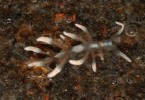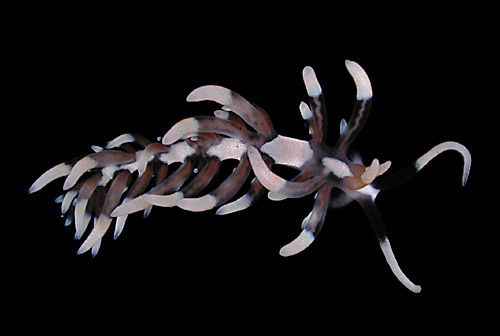| Home |
| Acknowledgments |
| Conventions |
| Glossary |
| Maps |
| References |
| Links |
| Articles |
| Thumbnails |
| Species
list |
| Family |
| Next
species |
Additional Photos

2nd animal

side

with yellow

young, 3 mm

Phyllodesmium sp. #2

| Maximum size: 15 mm. Identification: This species has a nearly transparent body decorated with opaque white on the cerata tips, rhinophore tips, cephalic tentacles and notum. The bases of the rhinophores are pale orange and the tips of the cerata may have a faint peach tinge. The branches of the digestive gland in the cerata are strait to weakly spiral without side branches and the tips of the cerata and rhinophores may appear slightly wrinkled when partially contracted. Sometimes, the contracted cerata show a tinge of yellow. It may be distinguished from the similar appearing Caloria sp. #2 by the more sharply margined white patches on the notum and the white rhinophore tips. Natural history: Phyllodesmium sp. #2 is a moderately rare nocturnal species. Most Maui animals were found in a moderately protected rocky habitat at a depth of 1 to 1.5 m (3 to 5 ft). Two animals were found, respectively, in a Halimeda kanaloana bed at 8-20 m (26-66 ft) and a more exposed rocky habitat at 8 m (26 ft). The rhinophores and cerata are contractile and the latter are "flared" in response to disturbance. The lack of side branches on the digestive gland suggests that the species doesn't store zooxanthellae. (Note 1) Distribution: Big Island, Maui, Kauai and Niihau. Taxonomic notes: It was first recorded in Hawaii from Hekili Point, Maui by CP on June 9, 1991. Photo: PF: 10 mm: found by CP; Hekili Point, Maui; June 9, 1991. Observations and comments: Note 1: Although it hasn't been confirmed by observation, the habitat of this species suggests that it may feed on the octocoral Sarcothelia edmondsoni. |
| Thumbnails |
Species
list |
Family | Next species | Top |